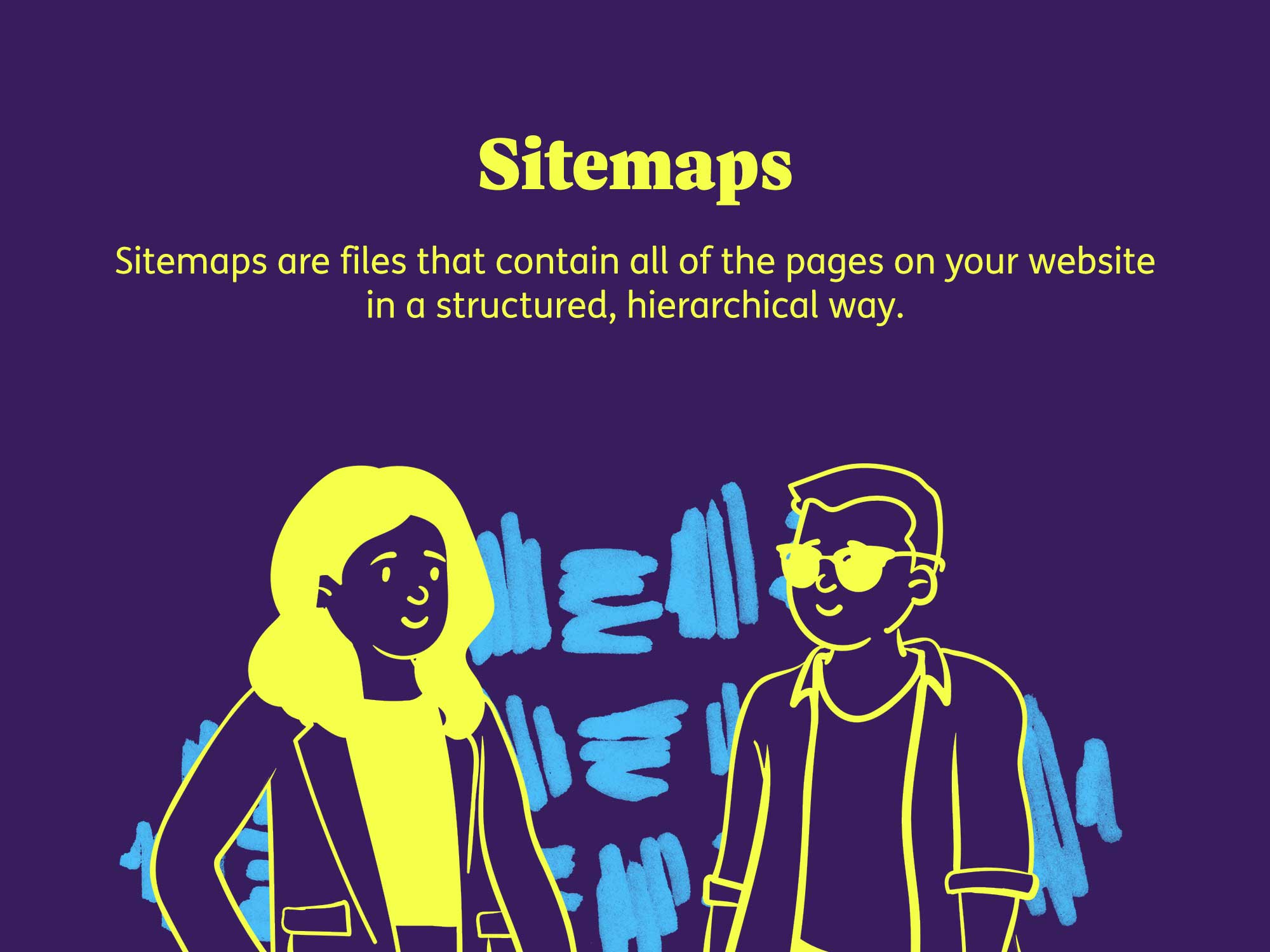Learn how to add XML and HTML sitemaps to your Shopify store, and why it makes sense to use an app.
You don’t have time to become a sitemap expert.
Are you busy running a Shopify store? I’ve personally helped over 250 merchants launch their Shopify stores, I know firsthand that it can feel overwhelming to connect all the technical dots.
Let’s face it. You don’t have time to become a sitemap expert.
Luckily, this guide contains everything you need to know about Shopify HTML sitemaps and XML sitemaps. And nothing more. I cover what they are, why you should even care about them, and how to add them to your store. Read on to learn the fundamentals.
Then, if you have a particular area of interest, dive into the detailed breakdowns of each topic to deepen your knowledge.
What are sitemaps?
Sitemaps are files that contain all of the pages on your website in a structured, hierarchical way. They make it easy for:
- search engines to crawl and index your website
- users to navigate your website.
They help improve user navigation, SEO, and accessibility. They also provide search engines with more information about your website, such as the weight of each page, or if pages have news content whose relevance is time-sensitive.
Discover what sitemaps are, the types that exist, see some examples, and learn why they should be used in our beginner’s guide to sitemaps.

Types of sitemaps
There are two main types of sitemaps: HTML sitemaps and XML sitemaps. Standard XML sitemaps and HTML sitemaps are the most important for your Shopify store. There are some other commonly used sitemaps which have a more niche usage case:
There are also some other commonly used sitemaps which have a more niche usage case:
- XML Sitemaps: a file that lists all of a website’s pages to help search engines find them.
- HTML Sitemaps: a page on a website that lists all of the website’s pages in an organized hierarchy to help users find content easier.
- Image Sitemaps: a type of XML sitemap with information about the images on your website.
- Video Sitemaps: provides search engines with information about the videos on your website.
- News Sitemaps: provides search engines with website URLs containing news content.
- Mobile Sitemaps: a type of XML sitemap to support mobile versions of websites
Examples of sitemaps
Viewing examples of sitemaps will help you understand how information is structured to help search engines crawl and index your websites. Here are some examples of the most common types of sitemaps:
- XML Sitemaps: This is an example of the Shopify-generated XML sitemap all stores have access to.
- HTML Sitemaps: This HTML sitemap outlines all of the pages on this Shopify website.
- Image Sitemaps: This is an example of an XML image sitemap by xml-sitemaps.com
- News Sitemaps: This example of a news sitemap includes title of each article, the URL where each article lives, and the date it was published.
Reasons to use sitemaps
Although HTML and XML sitemaps are equally important, they each serve a slightly different purpose. These are the top 3 reasons why every store should have each type of sitemap:
HTML Sitemaps
- Improved user navigation: An HTML sitemap gives website users a clear page structure overview for easy navigation.
- SEO improvements: Like XML sitemaps, HTML sitemaps aid in indexing deeply nested pages.
- Improve accessibility: An HTML sitemap’s clear, hierarchical layout aids those using screen readers and keyboards to navigate your site, aligning with WCAG guidelines.
XML Sitemaps
- Get found by search engines: An XML sitemap helps search engines find new or recently updated websites.
- Surface buried content: XML sitemaps find deeply nested pages and assign more weight to valuable pages.
- Improve crawling speed: An XML sitemap guides search engines for efficient crawling, helping them to index your website faster.
How to add sitemaps on your Shopify store
If you’re looking at adding sitemaps to your Shopify store, using an app will make this process much easier. But there are ways you can do this natively.
Since the process for submitting an XML sitemap is different from creating an HTML sitemap, I’ll go over each one separately below.
Native Shopify solutions for sitemaps
Adding XML or HTML sitemaps natively within Shopify is not easy to do. There are workarounds, but they will require more time and technical skill to achieve compared to app solutions:
There are some workarounds:
- Custom XML Sitemap: List and code URLs in XML format, host the file externally, and submit your sitemap to search engines.
- Shopify-Generated XML Sitemap: Verify your site with Google, add the HTML tag via Shopify, and then submit your XML sitemap via Google Search Console.
- HTML Sitemap: Create a new page template and then insert a custom code snippet so the HTML sitemap updates when changes are made to the site.
Shopify app solutions for sitemaps
Using an app to create a HTML sitemap custom XML sitemap is the way to go for most stores. If you’re wondering which app to use, I’ve compared app solutions for adding a sitemap to native solutions and recommend the best app:
Magical XML/HTML sitemap is the best overall app for small and medium stores looking to get set up with a simple HTML sitemap or submit their XML sitemap within minutes.
Benefits of using sitemaps on Shopify
HTML Sitemaps
HTML sitemaps offer a range of benefits:
- Boost SEO: HTML sitemaps complement XML sitemaps, helping crawlers rank your store higher by prioritizing and organizing important content.
- Increase usability: HTML sitemaps help users navigate your store and make your website more user-friendly.
- Improve accessibility: Providing a sitemap is useful, especially for people with disabilities who may have difficulty using complex navigation bars on different parts of your store.
- Easily identify site structure issues: An HTML sitemap provides a quick content overview, making it easier to spot duplicates and outdated pages, remove them, and prevent search engine penalties.
XML Sitemaps
An XML sitemap helps search engines effectively crawl, index, and understand the structure of a website. They are so important that Shopify automatically generates an XML sitemap for all its stores.

How to set up an HTML sitemap and access your XML sitemap with Magical XML/HTML Sitemap
Setting up XML and HTML sitemaps with the Magical Sitemap App is a fast and easy process that will have your sitemap ready in just minutes.
Once your HTML sitemap is set up, it’ll automatically update any changes in content so you’ll never have to tinker with it manually. Once your XML sitemap is submitted to Google, you shouldn’t have to submit it again unless your website undergoes significant changes to page structure or a complete overhaul.
Our guide includes the following instructions to set up the XML/HTML Magical Sitemap App:
- Initial App Setup: Open the app from the Shopify store to view detailed instructions.
- Create your HTML sitemap: Click “Create sitemap” to generate the sitemap. By default, it will list all Products, Collections, and Pages on your store.
- Add a link to your HTML sitemap: Go to Online Store > Navigation, add a menu item, and link to /tools/sitemap.
- Remove link to your HTML sitemap: Go to Online Store > Navigation, delete the menu item, confirm, and save.
- Submit your XML sitemap to Google: Verify your website with Google and then submit your Shopify-generated XML sitemap via Google Search Console.
- Customizing the HTML sitemap: Open the app, click ‘Add Item,’ choose the content type, and name the page.”
The process of submitting your XML sitemap or creating an HTML sitemap is much easier with an app.
Magical XML/HTML Sitemap FAQs
Since my team and I provide support for our customers who are setting up their sitemaps, we tend to get a lot of questions about sitemaps, what they are, why they’re important, and how to install them.
We’ve compiled a list of the most Frequently Asked Questions About the XML/HTML Magical Sitemaps App, which includes answers to:
- How does this app work? The Magical XML/HTML Sitemap app features an intuitive HTML sitemap builder on the back-end as well as access to your Shopify-generated XML sitemap and instructions for submitting it to Google.
- Does the HTML sitemap generate links to product variants? You can add variants manually via the sitemap builder, but the generator links only to top-level products and not variants.
- Does this app generate an image XML sitemap? No. At this time the app offers access to your Shopify-generated XML sitemap. Shopify does not generate an image XML sitemap.
- Why should I use an HTML sitemap? An HTML sitemap is primarily relevant for users of your website and supports them in navigating through your site.
- Why should I use an XML sitemap? XML sitemaps help search engines find all website content. Use both sitemap types for SEO and usability.
Compare the best Shopify sitemap apps
The process of submitting your XML sitemap or creating an HTML sitemap is much easier with an app.
I reviewed the apps that are available on the Shopify App Store and found most apps to be simple and low-cost. Some apps have simple pricing while others tier their services to cater to different store sizes. Some also have more advanced SEO features that your store might not need.
You can read our article Compare the 4 Best Shopify Sitemap Apps for a more detailed look at the best apps for sitemaps.
The Best Sitemap Apps:
- Magical XML/HTML Sitemap – best overall app, but you cannot customize XML sitemap.
- Sitemapper Pro SEO Sitemap – well-rounded features, but expensive for large inventories.
- Custom XML Sitemap Builder Pro – truly custom XML sitemap, but no design customization for HTML sitemaps.
- SEO Sitemap Builder – fast and easy HTML sitemap, but relatively expensive
Conclusion
Managing sitemaps for your Shopify store is important for your store’s visibility and search engine ranking. Submitting your XML sitemap and having an HTML sitemap will allow search engines to index all of your website’s pages properly. This will help improve your ranking and ultimately drive more organic traffic to your site.
Shopify HTML sitemaps also include user experience benefits which make your website more user-friendly, more accessible, and easier to navigate.
Using an app is the easiest way to add and manage your sitemaps for your Shopify store. Most XML and HTML sitemap apps offer an easy-to-use interface that makes it easy to set up. They also offer ongoing features that keep your sitemaps optimized over time. Apps eliminate the need for technical expertise and ensure that your sitemaps are always up-to-date and functioning correctly.
I recommend using Magical XML/HTML Sitemap. This is the best app for small or medium-sized stores who don’t know much about sitemaps and just want to get it taken care of. It’s a fast and easy setup and ongoing support will mean you never have to worry about your sitemaps again.
Magical XML/HTML Sitemap
Easily add customizable XML/HTML sitemaps, improve navigation, and start ranking higher on Google with the Magical XML/HTML Sitemap app.
